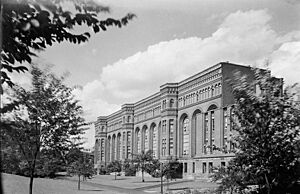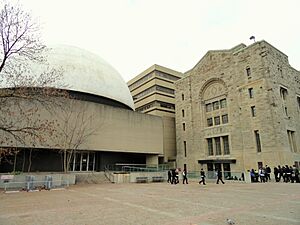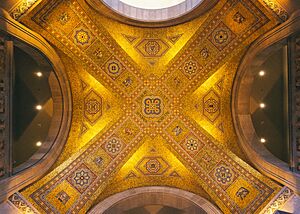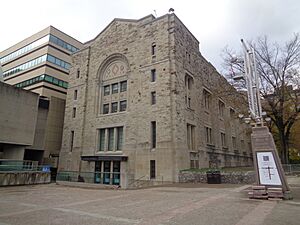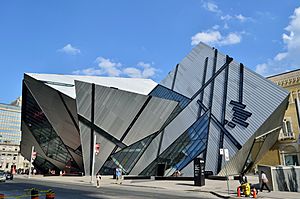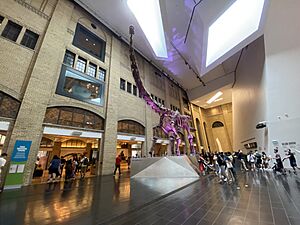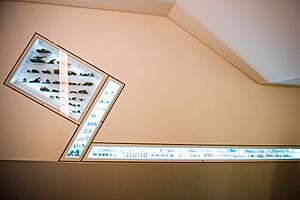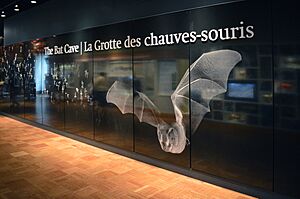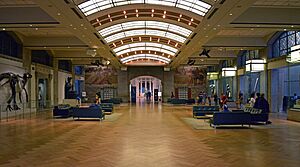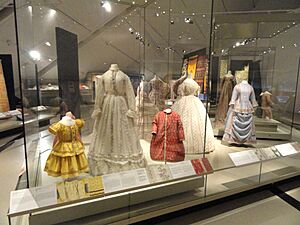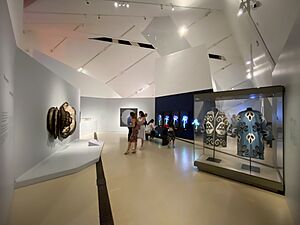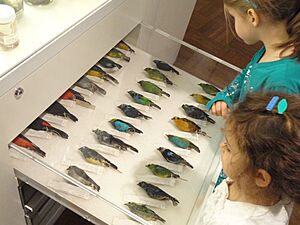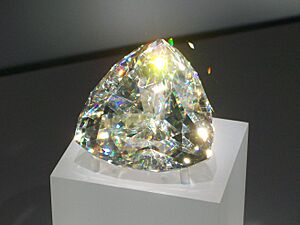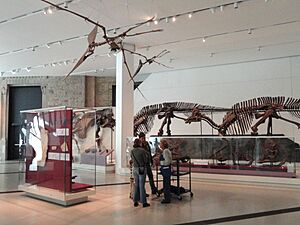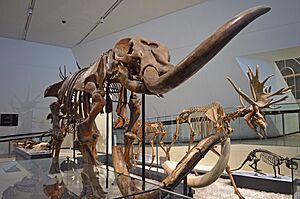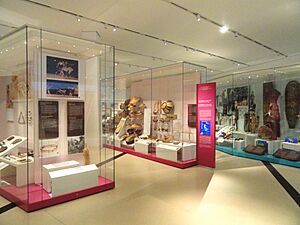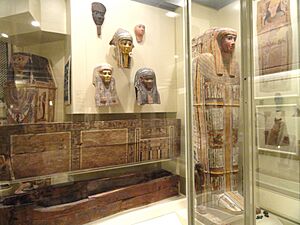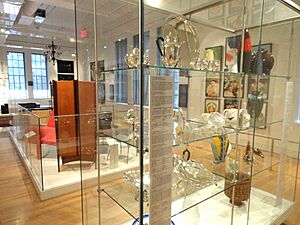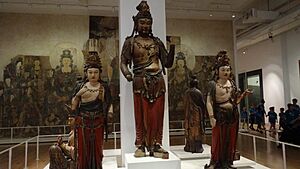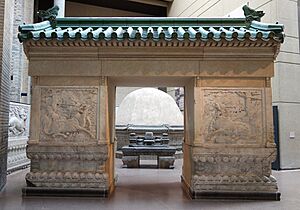Royal Ontario Museum facts for kids
 |
|
 |
|
| Lua error in Module:Location_map at line 420: attempt to index field 'wikibase' (a nil value). | |
| Established | 16 April 1912 |
|---|---|
| Location | 100 Queen's Park Toronto, Ontario M5S 2C6 |
| Collection size | 18,000,000+ |
| Visitors | 1,440,000 |
| Owner | Government of Ontario |
| Public transit access | |
| Built | 1910–1914, addition: 1931–32 |
| Architect | Darling & Pearson, addition: Chapman & Oxley |
| Sculptor | Wm. Oosterhoff |
| Designated | 2003 |
| Reference no. | Heritage Easement Agreement AT347470 |
The Royal Ontario Museum (ROM) is a huge museum in Toronto, Ontario, Canada. It shows amazing art, world cultures, and natural history. It is one of the biggest museums in North America and the largest in Canada. Over one million people visit it every year, making it the most-visited museum in Canada.
The ROM is located near Queen's Park and the University of Toronto. Its main entrance is on Bloor Street West. The Museum subway station is even named after it! Since 2008, the station looks like parts of the museum's collections.
The museum first opened on March 19, 1914, after being officially started on April 16, 1912. For many years, it worked closely with the University of Toronto. In 1968, it became an independent agency of the Government of Ontario. The ROM is also Canada's largest place for field research, with projects happening all over the world.
With more than 18 million items and 40 galleries, the museum has a huge variety of collections. These include dinosaurs, minerals, and meteorites. You can also see Canadian and European historical items, plus art from Africa, the Near East, and East Asia. It has the world's largest collection of fossils from the Burgess Shale in British Columbia, with over 150,000 specimens. The museum also has many items of design and fine art, like clothing and Art Deco pieces.
Contents
A Look Back: The ROM's History
The Royal Ontario Museum officially began on April 16, 1912. It was run by both the Government of Ontario and the University of Toronto. Its first collections came from the university and the Ontario Department of Education. On March 19, 1914, the Duke of Connaught, who was Canada's governor general, opened the museum to the public. The museum was built close to the University of Toronto. The first building cost about $400,000 to build. It was planned to be much larger, eventually forming an H-shape.
The museum's first big addition opened on October 12, 1933. This $1.8 million project added the east wing, which faces Queen's Park. This happened during the Great Depression, so local materials and workers were used. Workers even took turns digging the foundations by hand.
In 1968, the museum became a separate organization from the University of Toronto. It also took over the new McLaughlin Planetarium. The planetarium was named after Samuel McLaughlin, who gave $2 million for its construction.
Another major expansion happened between 1978 and 1984. This added the Queen Elizabeth II Terrace Galleries and a curatorial centre. The new galleries were opened in 1984 by Queen Elizabeth II. This $55 million expansion won a Governor-General's Award in Architecture.
In December 1995, the McLaughlin Planetarium closed due to government budget cuts. The space was later sold to the University of Toronto in 2009 for $22 million.
Starting in 2002, the museum began a huge renovation called Renaissance ROM. The Ontario and Canadian governments gave $60 million, and Michael Lee-Chin donated $30 million. The goal was to attract more visitors and get more money for research and programs. The most famous part of this project was the Michael Lee-Chin Crystal. This unique, crystal-shaped building was designed by architect Daniel Libeskind. The Crystal replaced the Terrace Galleries. The first renovated galleries opened on December 26, 2005. The Michael Lee-Chin Crystal officially opened on June 2, 2007. The whole project cost about $270 million.
In 2024, the museum began new renovations. These changes will improve the Crystal's design and add more natural light to its main hall. They also include a new staircase and a redesigned entrance plaza for outdoor events.
Amazing Architecture: The ROM's Buildings
The ROM is made up of several parts. These include the first building from 1914, the east wing added in 1933, the curatorial centre from 1984, and the Michael Lee-Chin Crystal from 2007. The original building is a protected heritage site in Toronto.
Old Buildings and East Wing
The first building, now the western wing, was designed by Frank Darling and John A. Pearson. It mixes Italianate and Neo-Romanesque styles. It has strong, heavy walls with rounded and arched windows.
The eastern wing, facing Queen's Park, was designed by Alfred H. Chapman and James Oxley. It opened in 1933. This part includes the museum's fancy Art Deco and Byzantine-inspired rotunda. The rotunda has a new main entrance. This wing used a neo-Byzantine style with rough stone and different colored stones in patterns. It also has some Gothic Revival details like carvings and gargoyles. The rotunda's beautiful ceiling is covered in gold back painted glass mosaic tiles. These tiles show colorful patterns and images of real and mythical animals.
In 2005, the older parts of the museum had a big renovation. Galleries were made larger, and windows were uncovered. The original early 1900s architecture was made more visible. The outside of these buildings was cleaned and restored. This was the biggest heritage project in Canada. The renovation also brought back the original oak doors in the Rotunda.
The first plan for the ROM in 1909 imagined a grand, square building. It would have corridors meeting in the middle with a domed rotunda. This design was meant to feel like the grand palaces of the 17th and 18th centuries.
Since late 2017, the eastern entrance has been under renovation to become another entrance. It now includes ramps and is close to Museum station.
Curatorial Centre
The curatorial centre is the southern part of the museum. It was designed by Gene Kinoshita and finished in 1984. This building has a simple modernist style, using concrete, glass, and pre-cast panels. It holds the museum's offices and stores artifacts not currently on display. In 2006, it was renamed the Louise Hawley Stone Curatorial Centre. This was to honor Louise Hawley Stone, who gave many artifacts and collections to the museum. She also left $49.7 million to help maintain the building and buy new artifacts.
The Michael Lee-Chin Crystal
The "Michael Lee-Chin Crystal" is a striking, crystal-shaped addition to the museum. It replaced the Queen Elizabeth II Terrace Galleries. This multi-million dollar expansion, designed by Daniel Libeskind, opened in 2007. It has a new sliding door entrance on Bloor Street. The Crystal is covered in 25 percent glass and 75 percent aluminum, built on a steel frame. Its angled walls do not touch the old buildings but connect the new and old parts.
The Crystal's design is similar to other buildings by Libeskind, like the Jewish Museum in Berlin. The steel frame was made in Hamilton, Ontario. The special aluminum cladding was made in Germany.
On June 1, 2007, Canada's governor-general, Michaëlle Jean, attended the Crystal's opening. The building's sharp, angular design caused some debate. Some critics called it one of the ten ugliest buildings in the world. Others praised it as a landmark. The project also went over budget and took longer than planned.
The main lobby inside is a three-story tall space called the Hyacinth Gloria Chen Crystal Court. It has balconies and is next to the J. P. Driscoll Family Stair of Wonders. Inside the Crystal, you can find a gift shop, a cafeteria, seven new galleries, and Canada's largest temporary exhibition hall in a museum. These galleries offer amazing visuals and stories through art and artifacts.
In October 2007, there were reports of water leaks in the Crystal. This raised concerns about how well the building would handle weather, especially its first winter.
Offsite Storage
Some of the ROM's collections are not shown in the museum or other museums. These items are kept in various storage locations around the Greater Toronto Area.
Explore the Galleries
The ROM used to have five main galleries: archaeology, geology, mineralogy, paleontology, and zoology. The displays were quite simple. For example, the insect exhibit had rows of specimens with only their names and locations.
By the 1960s, displays became more engaging. The first dinosaur gallery, for instance, showed fossils in active poses with background paintings. Displays started to explain more, sometimes offering different ideas for visitors to think about. This continued, making galleries more dynamic. A great example is The Bat Cave, which uses sounds and air to make you feel like you are walking through a cave with bats flying around.
Today, galleries are often named after people who have given a lot of money or collections to the museum. There are two main types of galleries: Natural History Galleries and World Culture Galleries.
The Samuel Hall Currelly Gallery is a large space on Level 1. It connects the east and west parts of the museum. This gallery acts as the main lobby after you enter. Unlike other galleries, it doesn't focus on one topic. Instead, it shows a mix of items from the museum's entire collection.
Costumes and Textiles
The Patricia Harris Gallery of Costumes and Textiles displays about 200 items. These pieces, from the 1st century BC to today, are changed often because they are delicate. Textiles and fashion show how cultures lived, their customs, and their economies. This gallery highlights how textile design and fashion have changed over time. You can see weaving, needlework, ancient printed textiles, and silks here.
Interactive Fun
The Patrick and Barbara Keenan Family Gallery of Hands-On Biodiversity teaches visitors about how all living things are connected. It's a fun and interactive space for all ages. You can touch specimens and use interactive displays. Gallery staff help visitors learn about the living world. Objects like mossy frogs, a shark jaw, snakeskin, and a replica fox's den help young visitors connect with nature.
Contemporary Culture
The Roloff Beny Gallery of the Institute for Contemporary Culture (ICC) hosts the ROM's modern art exhibitions. This large gallery shows exhibits that link today's culture and events with the museum's natural and world collections. It has featured shows on fashion photography, street art, and modern Chinese and Japanese art. In 2018, it showed Here We Are: Black Canadian Contemporary Art, featuring works by Black Canadian artists.
Natural History Galleries
The natural history galleries are all on the second floor. They have collections and examples of animals like bats, birds, and dinosaurs.
Nature and Animals
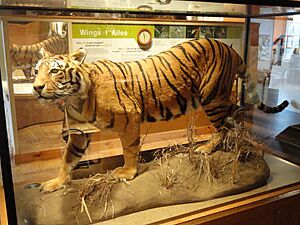
The Life in Crisis: Schad Gallery of Biodiversity opened in late 2009. It features endangered species like a polar bear, a giant panda, and a white rhinoceros. You can also see recently extinct species, such as a passenger pigeon and a great auk. Skeletons of a dodo and a giant moa are also on display. The gallery shows why we need to protect nature and learn about the main causes of extinction: overhunting, habitat destruction, and climate change. This gallery won an Award of Excellence in 2009. It aims to promote protecting Earth's biodiversity.
The Life in Crisis gallery has three main areas: Life is Diverse, Life is Interconnected, and Life is at Risk. These themes help tell the big story of biodiversity in an engaging way.
A part of the gallery called Tallgrass Prairies and Savannas shows one of Ontario's most endangered habitats. It highlights efforts to protect and restore these areas.
The Gallery of Birds displays many bird specimens from past centuries. A large "Birds in flight" display shows stuffed birds in a glass case. Dioramas teach visitors about different bird species and how environmental changes threaten them. You can also pull out drawers to look closely at eggs, feathers, and nests.
The ROM bought a blue whale that washed ashore in Newfoundland. Its skeleton and heart were part of a traveling exhibit until September 4, 2017.
The Bat Cave offers an immersive experience. It shows over 20 bats and 800 models in a recreated habitat. Educational panels and videos are also included. The bat cave reopened on February 27, 2010, after big renovations. It recreates the St. Clair Cave in Jamaica, based on ROM research there in 1984.
Earth and Space
The Teck Suite of Galleries: Earth's Treasures has almost 3,000 specimens. These include minerals, gems, meteorites, and rocks. They range from 4.5 billion years old to today. These items were found on Earth, the Moon, and beyond. They show Earth's active geological environment. Important specimens include pieces of the Tagish Lake meteorite. The Light of the Desert, the world's largest faceted cerussite, is another special piece.
These galleries include the Barrick Gold Corporation Gallery, the Canadian Mining Hall of Fame Gallery, the Gallery of Gems and Gold, and the Vale Gallery of Minerals.
Fossils and Evolution
The Reed Gallery of the Age of Mammals explores how mammals grew after the non-avian dinosaurs died out. It has over 400 specimens from North and South America. There are also 30 fossil skeletons of extinct mammals. A highlight is the sabre-toothed Dinictis.
The James and Louise Temerty Galleries of the Age of Dinosaurs and Gallery of the Age of Mammals show many complete non-avian dinosaur skeletons. You can also see early birds, reptiles, mammals, and marine animals from the Jurassic to Cretaceous periods. A main attraction is Gordo, one of the most complete Barosaurus skeletons in North America. It is the largest dinosaur on display in Canada.
The Willner Madge Gallery, Dawn of Life opened in 2021. It focuses on the evolution of life in the Paleozoic Era, from billions of years ago to the Late Triassic. It highlights many fossil sites from Canada, like the Burgess Shale in British Columbia. The gallery has six sections, covering different ancient periods. Notable items include fossils from the Burgess Shale and the Dimetrodon borealis skeleton.
The ROM also has a Zuul crurivastator skeleton in its dinosaur collection. It is one of the most complete ankylosaurid specimens ever found.
World Culture Galleries
The world culture galleries display many objects from around the globe. These range from Stone Age tools from China and Africa to 20th-century art and design. In July 2011, several new permanent galleries were opened. The Government of Canada and the ROM each gave $2.75 million for this project. These galleries are on the first, third, and fourth levels of the museum.
Africa, the Americas, and Asia-Pacific
The Shreyas and Mina Ajmera Gallery of Africa, the Americas and Asia–Pacific has 1,400 artifacts. These show the art and cultures of indigenous peoples from four areas: Africa, the American continents, the Asia–Pacific region, and Oceania. You can see ceremonial masks, ceramics, and even a shrunken head.
South Asia and Middle East
The Sir Christopher Ondaatje South Asian Gallery has a diverse collection of objects. These include decorative art, armor, and sculptures. They represent the culture of the Indian subcontinent. The gallery has about 350 objects covering over 5,000 years of history. It is divided into sections like "Imagining the Buddha" and "Courtly Culture." Here, you can find the (Untitled) Blue Lady sculpture by artist Navjot Altaf.

The Wirth Gallery of the Middle East explores civilizations from the Palaeolithic Age to AD 1900. These cultures lived in the Fertile Crescent, which includes areas like Mesopotamia (Iraq) and Persia (Iran). Over 1,000 artifacts show the writing, technology, and daily life of ancient Sumerians, Akkadians, Babylonians, and Assyrians. These civilizations made big advances in writing, math, and medicine. Pieces include plastered human skulls from around 8000 BC. Another famous piece is the Striding Lion, a wall relief from King Nebuchadnezzar II's palace in Babylon.
Mediterranean and Nile Valley
The Eaton Gallery of Rome shows a thousand years of ancient Roman culture. It has Canada's largest collection of classical antiquities, with over 500 objects. These range from marble portraits to Roman jewelry. The gallery also features the Bratty Exhibit of Etruria, which teaches about the Etruscans.
The Joey and Toby Tanenbaum Gallery of Rome and the Near East shows the life and culture of societies under Roman rule. The same space also has the Joey and Toby Tanenbaum Gallery of Byzantium. This covers the history of the Byzantine Empire from AD 330 to 1453. It has over 230 artifacts like jewelry, glasswork, and coins.
The A. G. Leventis Foundation Gallery of Ancient Cyprus has about 300 artifacts. It focuses on art from Cyprus between 2200 and 30 BC. The collection includes a reconstructed open-air sanctuary. It also has a rare bronze statue of a man carrying a large copper block.
The Gallery of Africa: Egypt focuses on the life and afterlife of Ancient Egyptians. It has many artifacts, such as tools, jewelry, and funerary items. The exhibit includes canopic jars and mummy cases. One famous mummy is Djedmaatesankh, a female musician. Another is Antjau, a wealthy landowner. Other items include the Book of the Dead of Amen-em-hat, a 7-meter-long scroll. You can also see the Bust of Cleopatra and the Statue of Sekhmet.
The Galleries of Africa: Nubia show objects from the ancient civilization of Nubia in modern-day Sudan. The Nubians were an early urban society in Africa and rivals of Egypt.
The Gallery of the Bronze Age Aegean has over 100 objects from Ancient Greece. These include items from the Cycladic, Minoan, Mycenaean, and Geometric periods. The collection ranges from 3200 BC to 700 BC.
The Gallery of Greece has 1,500 artifacts from the Archaic, Classical, and Hellenistic periods. It includes sculptures of gods, armor, and coins.
Canadian Culture

The Daphne Cockwell Gallery of Canada: First Peoples explores the cultures of Canada's earliest societies. These are the Aboriginal Peoples of Canada. The gallery has over 1,000 artifacts. They show the economic and social forces that shaped Native art.
The ROM has a large collection of Northwest Coast native art. It was gathered by Reverend Dr. Richard Whitfield Large between 1899 and 1906. This "R. W. Large Collection" is very important because of its detailed records.
There is also a changing display of modern Native art. A section is dedicated to the artist Paul Kane. A theater tells traditional stories. Outside this gallery, the main staircase wraps around the Nisga'a and Haida Crest Poles.
The Sigmund Samuel Gallery of Canada used to display early Canadian items. Most of these were historical decorative and pictorial arts. It had about 560 artifacts from early European settlement to the start of the industrial era. The gallery closed in 2022.
East Asian Treasures
The Chinese Galleries have four sections. These are the Bishop White Gallery of Chinese Temple Art, the Joey and Toby Tanenbaum Gallery of China, the Matthews Family Court of Chinese Sculpture, and the ROM Gallery of Chinese Architecture.
The Bishop White Gallery of Chinese Temple Art has three of the world's best-preserved temple wall paintings. These are from the Yuan dynasty (AD 1271–1386). It also has wooden sculptures of various bodhisattvas from the 12th to 15th centuries. Famous paintings include the Homage to the Highest Power and Paradise of Maitreya.
The Joey and Toby Tanenbaum Gallery of China has about 2,500 objects. They cover almost 7,000 years of Chinese history. The gallery is divided into five sections, each focusing on a different period. You can see items from jade discs to furniture.
The Matthews Family Court of Chinese Sculpture has many sculptures. They cover 2,000 years of Chinese sculptural art. It also shows smaller objects that explore how religions developed in China. Notable items include Wei Bin's Temple Bell and the Companion statues: Kashyapa and Ananda. The gallery also features one of the Yixian glazed pottery luohans.
The ROM Gallery of Chinese Architecture has one of the largest collections of Chinese architectural artifacts outside of China. It is the first gallery of its kind in North America. Artifacts include the Tomb of General Zu Dashou. This tomb includes an altar, stone burial mound, and archway. The gallery also has a reconstruction of an Imperial Palace building from Beijing's Forbidden City.
The Gallery of Korea is the only permanent gallery of Korean art in Canada. It shows about 260 items from the Korean peninsula. These include furniture, ceramics, and metalwork from the 3rd to 20th centuries AD. They show the many achievements of Korean culture. The influence of Buddhism is shown with statues, including a śarīra casket.
The Herman Herzog Levy Gallery is where many East Asian traveling exhibitions are shown.
The museum also used to have the Prince Takamado Gallery of Japan. It had Canada's largest collection of Japanese artworks. This included changing displays of ukiyo-e prints and a unique tea master collection. The gallery was named after the late Japanese Prince Takamado.
European Art and History
The Samuel European Galleries have over 4,600 objects. They show how decorative and other arts developed in Europe from the Middle Ages to the 20th century. Special rooms show changes in style during the Renaissance, Baroque, Rococo, Neoclassical, and Victorian periods. Other collections include Judaica, Art Deco, and Arms and Armour. Here you can see the Earl of Pembroke's Armour, made between 1550 and 1570. Another important piece is the Otho tazza. This was one of 12 cups that made up the Aldobrandini Tazze, a set of Renaissance-era cups.
Making the Museum Accessible
The ROM offers programs and services to make the museum welcoming for everyone. These are available in English and French. They include:
- Tours where you can touch things
- An audio description program for people who are blind or have low vision
- Books with braille, raised pictures, large print, and color pictures
- Large-print maps of the museum
- Guides with large print
- Galleries where you can touch and interact with exhibits
- Gallery interpreters who lead active exploration activities
- American Sign Language interpretation, tours, and video podcasts
- Interactive touch screens
- A hearing loop system
- Assistive communication technology (Ubi-Duo) for real-time talks between deaf visitors and staff
Community Access Network
In 2008, the Royal Ontario Museum Community Access Network was created. It helps make the ROM more available to different communities. It gives free general admission tickets to many community and charity groups. Each year, thousands of tickets are given out. This program tries to remove barriers that might stop people from visiting the museum. Since 2008, it has grown into a larger effort to help visitors and organizations learn. Partners include United Way of Greater Toronto and Boys & Girls Clubs of Canada.
Images for kids
See also
 In Spanish: Museo Real de Ontario para niños
In Spanish: Museo Real de Ontario para niños
- List of art museums
- List of museums in Toronto


